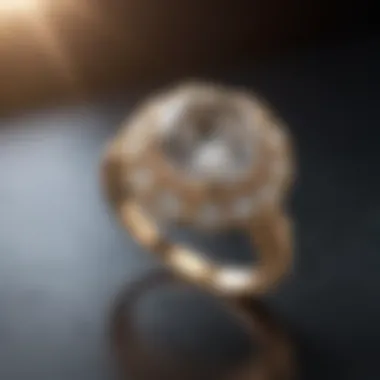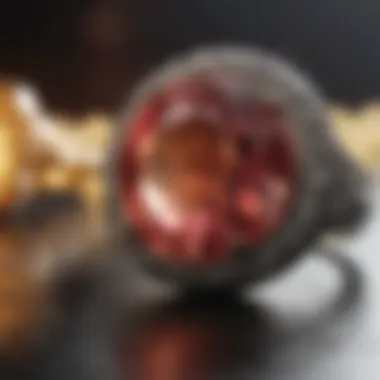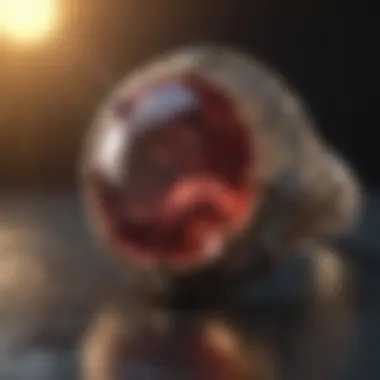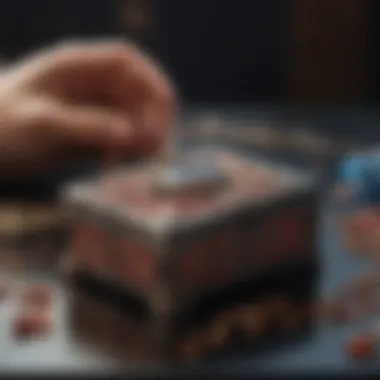Comprehensive Review of Allstate Jewelry Insurance


Intro
Delving into the realm of jewelry insurance is like stepping into a treasure trove of knowledge that goes beyond mere policy quotes. It’s akin to understanding the intricate weave of history, artistry, and financial protection surrounding valuable items. How do we safeguard some of life's most cherished possessions—those glittering diamonds and vibrant gemstones that adorn our lives? This exploration focuses on Allstate's jewelry insurance offerings, unraveling insights that help both enthusiasts and collectors navigate the landscape of jewelry protection. The importance of ensuring high-value pieces cannot be overstated, especially when you consider the emotional and financial value associated with them.
Every twist and turn in the insurance policy maze holds the potential to either shield your jewels from unwelcome surprises or leave you exposed to unforeseen costs. By examining the policy details, claims processes, customer testimonials, and more, this guide hopes to equip readers with the knowledge they need to make judicious choices regarding their prized pieces.
Understanding jewelry insurance is not merely a box to check; it’s a crucial element in the stewardship of personal and familial legacies. So, let’s unravel this topic, offering clarity and a pathway to the most informed decisions for the protection of your jewelry investments.
Intro to Jewelry Insurance
When it comes to the world of jewelry, the financial and sentimental value can be quite profound. Many people own significant pieces, whether handed down through generations or acquired for personal milestones. Jewelry often captures memories, emotions, and even stories, making its preservation paramount. This is where jewelry insurance steps in, acting as a guardian of these cherished items.
Importance of Protecting Valuable Items
Consider this: losing a beloved piece of jewelry can lead not just to the financial toll but also to the emotional devastation. Whether it's a family heirloom or a diamond engagement ring, the loss is not just about the item itself, but rather what it represents. Therefore, protecting such valuable items is imperative. Here’s why:
- Financial Security: Insuring your jewelry ensures that if an unforeseen circumstance occurs, you won't be left to foot the hefty bill alone. Imagine losing a stunning sapphire necklace; without insurance, replacing it could mean draining your savings.
- Peace of Mind: Having coverage provides reassurance. Knowing you are protected allows you to wear your jewelry with confidence, rather than keeping it locked away for fear of loss or damage.
- Historical Value: Some jewelry pieces may have historical significance or unique craftsmanship that's irreplaceable. Insurance can be a way to acknowledge and safeguard that legacy.
In short, jewelry insurance is a small price to pay for the peace of mind it brings, knowing that your collateral stories and memories are protected for the future.
Overview of Allstate Insurance
Allstate Insurance is a prominent name in the insurance landscape, offering a range of policies designed to cater to different needs. Their approach to jewelry insurance is built on several key pillars, making it an attractive option for those looking to protect valuable items.
- Broad Coverage Options: Allstate provides a variety of coverage plans that can be tailored to meet individual needs, whether for extensive collections or singular, high-value pieces.
- Customer-Centric Service: With a reputation for good customer support, Allstate aims to ensure that policyholders feel valued and understood when it comes to their insurance needs.
- Claim Process Transparency: The clarity with which they outline their claims process signifies their commitment to making potentially stressful situations as smooth as possible.
Knowing more about Allstate's offerings sets the stage for a deeper dive into how their jewelry insurance can serve as a robust safety net for collectors, enthusiasts, and everyday wearers alike.
Understanding Allstate Jewelry Insurance
When it comes to safeguarding personal treasures, understanding Allstate Jewelry Insurance sets a solid groundwork for strategically navigating your coverage options. Given the immense sentimental and monetary value of jewelry, wrapping your head around the specifics and benefits of insuring these items is crucial. This section walks you through the core aspects of Allstate offerings.
First off, jewelry is not merely an ornament; for many, it represents memories, history, and beliefs—often passed down through generations. Therefore, protecting these items against loss, theft, or damage isn’t just a financial decision; it’s deeply personal.
Types of Jewelry Covered
Allstate Jewelry Insurance stands out for covering a wide range of jewelry types. From engagement rings that spark joy to vintage brooches that tell stories, Allstate’s policy typically includes:
- Engagement and Wedding Rings: These often hold immense emotional weight, making their protection crucial.
- Heirlooms and Antique Pieces: Whether it’s a family heirloom or a rare find, coverage is essential to keep their value intact.
- Fashion Jewelry: Valuable pieces from designers or just special pieces you've grown fond of can qualify.
- Custom-Made Jewelry: If you’ve crafted something unique, Allstate generally accommodates personalized pieces as well.
This broad scope allows policyholders to choose coverage that reflects the diverse nature of their collection.
Details of Coverage Policies
The nitty-gritty of Allstate’s coverage policies reflects their commitment to addressing the unique needs of jewelry owners. While specifics can vary, some common features include:


- Replacement Cost Coverage: Rather than merely reimbursing the original purchase price, Allstate often covers the replacement cost, allowing for refurbishment should the piece be lost or damaged.
- Worldwide Protection: Travel with peace of mind, as many policies extend coverage across the globe, whether you’re on a vacay in Paris or a weekend getaway.
- No Deductibles on Claims: In many instances, Allstate provides options that do not require a deductible, making it simpler to file claims without worrying about out-of-pocket costs.
"Understanding the specifics of your jewelry coverage can save you from unpleasant surprises at the worst moment."
This level of access and adaptability can instill confidence in policyholders knowing they’re backed by a provider that values their treasures as much as they do.
Exclusions and Limitations
It’s important to step back and consider the limits of any insurance policy. With Allstate, there are some exclusions to note:
- Wear and Tear: Routine wear and tear generally isn't covered, as expected with most policies.
- High-Risk Activities: If you're planning on wearing that diamond necklace during a boxing match, don't be surprised if claims are denied.
- Certain Types of Jewelry: Occasionally, items like costume jewelry or pieces with overly sentimental value may not qualify for coverage. It’s always best to double-check what's included in your policy.
By grasping these exceptions, you can tailor your approach to coverage, ensuring your pieces remain safeguarded while understanding potential pitfalls.
Claims Process with Allstate
Understanding how to navigate the claims process with Allstate is crucial for policyholders who want to protect their jewelry from unforeseen circumstances. A smooth claims process can significantly reduce the stress following an incident involving lost, stolen, or damaged jewelry. This section outlines what one can expect in terms of initiating a claim, the necessary documentation, and how Allstate evaluates those claims.
Initiating a Claim
Making a claim with Allstate may seem daunting, but it doesn’t have to be. When an unfortunate incident occurs, the first step is to reach out to Allstate directly. You can initiate your claim online or over the phone, whichever is more convenient for you. The representative you speak with will guide you through the process, simplifying what might otherwise feel like a complicated maze. You’ll need to provide basic information about the loss or damage and your policy details. Remember, acting promptly is key. The sooner you report the claim, the smoother the process tends to unfold.
Documentation Requirements
Documenting the event thoroughly is essential in making your claim successful. Allstate requires certain documents to assess the validity of your claim. Here’s a list of common documentation you may need to gather:
- Proof of Ownership: Receipts, appraisals, or photos of your jewelry can serve as proof.
- Incident Report: If your jewelry was stolen, a police report will likely be needed.
- Photographic Evidence: Clear images of the damaged or lost items help in substantiating your case.
Being proactive by keeping records of your jewelry, including photos and appraisals, can fast-track the documentation process and ensure you’re prepared when it’s time to file a claim.
Claim Evaluation Procedures
Once your claim is submitted along with the required documentation, it transitions into the evaluation phase. Allstate has a designated team that reviews each case carefully. They will verify the details provided, assess the value of the items, and determine the eligibility of the claim according to policy terms.
It’s worth noting that this evaluation might include consultations with experts or appraisers, ensuring that assessments are accurate. The entire process typically takes a few weeks, but how long it takes can vary depending on the complexity of the case.
Always keep an open line of communication with your claims adjuster. Their insights can help clarify doubts and keep you informed about the status of your claim.
In summary, knowing how to effectively initiate a claim, understanding the required documentation, and being familiar with the evaluation procedures can relieve much of the stress linked with filing a claim with Allstate. Having this knowledge empowers you to act swiftly, making it a vital part of the overall insurance experience.
Policy Costs and Premiums
Understanding the costs associated with jewelry insurance policies is paramount for anyone looking to safeguard their prized possessions. Not only does it play a crucial role in a policyholder's financial planning, but it also significantly impacts the degree of protection one can achieve. Consumers need to weigh the balance between premium costs and the level of coverage when considering Allstate's offerings. In short, low premiums might sound appealing, yet they could come bundled with limited protection and potential exclusions. Conversely, higher premiums may provide broader coverage, but they also need to fit within one’s budget.


Factors Influencing Pricing
Several elements swirl together to determine the pricing model of jewelry insurance policies. Here are some of the core factors:
- Value of the Jewelry: A no-brainer, really. The more treasure you have, the heftier the premium. When insuring high-value items like diamond rings or antique necklaces, expect the costs to reflect their worth accurately.
- Type of Coverage: The variations between actual cash value versus replacement cost coverage can sway premiums significantly. Actual cash value considers depreciation, potentially lowering your payout. On the flip side, replacement cost coverage promises to replace your item without factoring in wear and tear, thus driving up premiums.
- Claim History: Just like your driving record matters to an auto insurer, your history with claims weighs heavily in this area. Frequent claims can signal higher risk, leading to elevated premiums.
- Location: Where you live can influence your rates. Urban areas may see higher rates due to increased risks, like theft or natural disasters, compared to rural settings.
- Security Measures: Keeping your valuables secure could lead to lower premiums. Insurers often dock prices for policyholders who invest in home security systems or safe storage options.
Comparison with Other Insurance Providers
In today's market, it's wise to shop around; jewelry insurance is no exception. When placed side by side, Allstate’s offerings reveal both strengths and weaknesses compared to competitors. Factors to consider include:
- Coverage Options: While Allstate offers a flexible framework for jewelry insurance, some competitors may specialize in niche coverage tailored specifically for rare gemstones or designer pieces.
- Premium Costs: Many find Allstate’s premiums competitive, but it’s smart to evaluate the overall cost against other providers like Chubb or State Farm.
- Customer Service: User experiences can differ substantially among insurances. Reading reviews on platforms like Reddit or Facebook may give insights into how well competitors handle claims and customer inquiries.
- Payout Policies: Not all insurers are created equal when it comes to how they disburse funds after a claim. Understanding these differences can make a world of difference should you ever need to utilize your insurance.
"The right jewelry insurance should not just cover your pieces but should also give you peace of mind."
This analysis aims to clarify how premiums and policy costs intertwine in the bigger picture of safeguarding your jewelry. As you navigate through the landscape of options, grasping these elements can convert daunting decisions into informed ones.
Customer Experiences and Reviews
When it comes to jewelry insurance, customer experiences and reviews play a crucial role in shaping a potential policyholder's decision. These insights provide a lens into how well policies perform in the real world, beyond just the glossy marketing materials. For gemstone enthusiasts, collectors, and jewelry designers alike, understanding other customers' experiences may bolster their confidence or raise red flags. Thus, this section delves into the invaluable feedback from those who have interacted directly with Allstate's jewelry insurance services, shedding light on the strengths and weaknesses of their offerings.
Positive Customer Feedback
Many policyholders have offered resounding praise for Allstate’s jewelry insurance. Their experiences often highlight several positive aspects:
- Accessibility of Service: Customers frequently express appreciation for how easily they can reach Allstate’s representatives. The responsiveness of claims representatives can make all the difference when anxiety runs high over a lost or damaged piece.
- Impactful Claims Process: Several reviews note that when claims are filed, the process seems straightforward and smooth. One customer recounted how their claim was processed in a matter of days — a relief considering the emotional weight of losing a cherished item.
- Comprehensive Coverage: Many believe Allstate provides a robust policy that addresses various types of jewelry, from engagements rings to antique pieces. Policyholders value the peace of mind that comes with knowing their prized items are protected.
"Insurance for my jewelry was something I thought I'd never need. After a pendant was lost, I was grateful for how straightforward Allstate made the claims process. They were with me every step of the way." - Satisfied Customer
Such positive anecdotes are key for anyone skeptical about purchasing jewelry insurance. It offers reassurance that, in times of distress, support is available.
Common Complaints and Issues
Despite the glowing feedback from some customers, there are also notable complaints that deserve attention. Understanding these issues is vital for potential policyholders:
- Claims Denials: A pattern of complaints arises regarding denied claims. Some customers have reported feeling frustrated when claims were rejected, often citing insufficient documentation as the reason. This highlights the importance of understanding documentation requirements early on in the process.
- Variable Customer Service Experiences: Some users have voiced concerns about inconsistent customer service. It appears that while many experience stellar support, others find it harder to get answers or assistance. Inconsistent experiences can lead to distrust, particularly during stressful claims situations.
- Pricing Discrepancies: A few customers have mentioned feeling that the premium prices were higher than expected compared to competitors. For money-conscious jewelry owners, this can be a significant factor in their decision-making process.
Comparative Analysis with Competitors
When considering jewelry insurance, a comparative analysis becomes a pivotal part of the decision-making process. This ensures policyholders grasp how Allstate measures up against other providers. Every insurance company's offerings can differ significantly, not just in terms of coverage details, but also in premium costs and customer service responsiveness. Understanding these nuances helps potential clients make informed choices that align with their specific needs and preferences.
Similar Providers in the Market
Several notable players exist in the jewelry insurance landscape alongside Allstate. Each provider boasts its own strengths and weaknesses:


- Jewelers Mutual: Renowned in the industry for its specialized focus on jewelry insurance, Jewelers Mutual often features comprehensive coverage tailored for both retail jewelers and individual collectors. Their protection varied from theft and loss to damage caused during repairs.
- State Farm: A household name, State Farm provides more generalized insurance that can cover jewelry, but may lack the specialized options that dedicated jewelry insurers offer. This could impact collectors who require specific types of coverage for unique pieces.
- Farmers Insurance: Another widespread insurer, Farmers includes jewelry under its homeowners policies but often applies sub-limits on valuable items, which might leave collectors needing more protection.
- Lemonade: Fast becoming a tech-savvy option, Lemonade appeals to a younger market with a user-friendly app. While it offers basic coverage, its lack of nuanced policies could mean jewelry enthusiasts miss out on necessary protections.
Each of these companies provides various advantages and disadvantages. Weighing them against Allstate's offerings is crucial for a comprehensive understanding of where to direct investments towards insurance.
Unique Selling Points of Allstate
Allstate has a few standout qualities that set it apart in the competitive jewelry insurance arena. Here are some of the unique selling points:
- Robust Claims Process: Allstate is known for its efficient claim handling, which can be a deciding factor for customers. Their digital tools facilitate quick reporting, making it easier to navigate through the claims maze.
- Comprehensive Coverage: Unlike some competitors, Allstate tends to provide flexible options tailored to individual needs. This might allow policyholders to include provisions for coverage during travel, which is particularly useful for frequent travelers.
- Established Reputation: With a longstanding history in the insurance industry, Allstate carries a level of trust that newer companies may not possess. This trust can reassure collectors who are wary of placing their valuable items under someone else's watch.
- Discount Offerings: Allstate often promotes discounts for bundling policies, offering potential savings for existing customers who might already have auto or homeowner's insurance with them.
Allstate's distinctive blend of technological support, flexible policy options, and solid reputation could make it a stronger choice for those looking to insure their cherished pieces.
In summary, when you line up Allstate against its competitors, it's clear that understanding the landscape is key to making an informed decision. Each provider has its unique setup, and Allstate emerges with certain advantages that could appeal specifically to diamond fans and jewelry collectors.
Recommendations for Policyholders
When it comes to safeguarding high-value jewelry, a well-crafted insurance policy isn't just a luxury—it's a necessity for serious collectors, designers, and enthusiasts. In this section, we’ll explore essential recommendations for policyholders. Understanding how to optimize your insurance coverage can mean the difference between recovering your investment or facing substantial loss.
Choosing the Right Level of Coverage
Selecting the appropriate level of coverage for your jewelry is crucial. It ensures you’re protected against potential losses or damages that could occur. There are generally two types of coverage options available: actual cash value and replacement cost.
- Actual Cash Value: This typically takes depreciation into account, meaning the payout will be lower than the item's original value. It’s best suited for items that may not appreciate and can lose value over time.
- Replacement Cost: On the other hand, this option does not consider depreciation. If a piece is lost or damaged, you can expect to receive the money needed to replace it with an identical or comparable item. This is generally the better choice for valuable pieces like vintage art-deco rings or rare gemstones, as these items can appreciate in value.
Consider the current market trends as well. An appraisal by a certified expert can provide critical insight into the value of your jewelry. These evaluations should be updated regularly, especially after significant market changes or if you've made enhancements to your pieces.
Tips for Maintaining Your Jewelry Value
Maintaining the value of your treasured jewelry pieces isn't just about insurance; it's about conscientious care and preservation. Here are several practical tips to help keep your jewels shining and valuable:
- Regular Cleaning: Invest in professional cleaning services or use gentle, suitable cleaners for specific gem types. Regular maintenance keeps your jewelry in pristine condition.
- Proper Storage: Store gemstones separately in soft pouches or lined boxes to avoid scratching. Avoid damp areas that may cause tarnishing or rusting.
- Insurance Reviews: Regularly review and update your jewelry insurance policy to reflect any changes in value or ownership of your pieces.
- Documentation: Keep all appraisals, receipts, and photographs organized and accessible. Should the need arise to file a claim, having this documentation will simplify the process considerably.
- Avoid Exposure to Harsh Chemicals: Regular exposure to household cleaning agents or personal care products can damage the material and luster of gemstones.
Ensuring your jewelry remains in excellent condition can preserve its investment value. An ounce of prevention is worth a pound of cure, especially in the jewelry world.
By taking these steps, policyholders can not only bolster the protection that Allstate's jewelry insurance provides but also enhance the overall value of their cherished collections. With informed choices, the journey towards safeguarding valuable items becomes much more holistic and rewarding.
Epilogue
As we wrap up our exploration of Allstate's jewelry insurance offerings, it's essential to reflect on what this type of coverage can mean for jewelry owners. For those who treasure their jewelry, not just for its aesthetic appeal but for its potential emotional and monetary value as well, ensuring that valuable pieces are protected is of utmost importance.
Final Thoughts on Allstate Jewelry Insurance
Allstate's jewelry insurance provides a way for collectors, enthusiasts, and everyday wearers to safeguard their treasured items. With various coverage plans designed to fit different needs, Allstate can cater to a range of expectations, whether you own a modest family heirloom or an extravagant diamond ring that sparkles under the brightest lights. The detailed policies offer something of interest, even for those who might not be looking to insure a vault of jewelry. Those policies consider replacement costs along with sentimental value, ensuring a more rewarding claims process when accidents happen. In summary, Allstate stands as a contender to keep your precious items safe, warranting a closer look into their specific offerings.
Affirming the Importance of Insurance Protection
The necessity of insurance for precious items cannot be overstated. Jewelry, unlike many other valuables, often carries an emotional connection to its owner. This unique bond makes it imperative for owners to have peace of mind—knowing that should anything go wrong, they won’t have to bear the brunt of the loss alone.
Investing in jewelry insurance allows for not just protection against theft or loss but also shields against unforeseen damage. One moment of carelessness or an unexpected mishap can transform a beloved piece into a ruin. Moreover, for those who might feel stressed or overwhelmed by the thought of insuring valuable assets, realizing that someone like Allstate could help manage those risks may come as a comfort.







